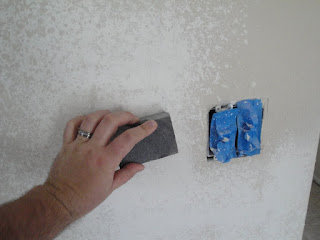Yeah, I had big plans and high hopes last week. I had a steely-eyed conviction that would make Lowe's employees tremble in fear and awe. I also apparently had way too many video games to play to get anything done. So, most of the week went by without any progress. We did make some progress, though, and you'll be treated to a painstaking description thereof so it seems like more work than it really was.
We planted the new flowers in a pot on the front step and it looks like two of the three plants are dying, despite my best efforts. I fear they may be overcrowded and I'm pretty terrible at remembering to water them. The one that's surviving is my favorite, at least. They're columbines, but they're little bushes on flowers instead of the normal stalks. They're really very pretty. Easily my favorite flower, so I'm hoping they survive and do well.
Also, we're trying to get the office sort of organized. Right now it has a folding table with two computers on it and the rest of the room is pretty much just boxes. We're going to get the boxes out of there and put in a real table for the computers. In that vein, we got some file cabinets. We've wanted to file our paperwork for al ong time, but didn't have the file space. Cabinets are really expensive, too. Like $120 for a 26.5" deep two-drawer one. Thankfully, we put my mom on the case and she found some for us for $50/ea on Craigslist. Woot! They're 'putty' colored, so we're going to paint them. We're doing a base of white with a stenciled design in the same blue as the accent wall. I'm really thinking they'll turn out well, so I'll post pictures of them as we go. Here they are as is:
They're actually nice and clean, and very well made. The brand is HON, which I think is a pretty good one. The only thing I know is that they beat the pants off the other file cabinets we own, and cost way less. These aren't super pretty yet, but I think we can fancy them up a bit. I have some ideas about them, and we'll just have to see how it all pans out. The plan is to use these as a base for our computer desk, but I'm actually thinking we may want to have them on their own and just make a regular desk for the computers. We'll just have to see how it all looks when we get the room cleared out and everything.
The other one thing I got done this past week was to fix some texture. Because of the nature of this beast, the pictures are going to be pretty much useless to you. I'll post them anyway, but it's all just going to look like walls.
This is the wall before I started. Rather, this is the wall after I patched the hole, textured, didn't like the texture, sanded, then re-textured then still didn't like the texture and had the handy-man do it. Since I'm a persnickety sort, I still wasn't overly pleased. He did a heck of a lot of texture around the house and most of it really just looked flattened. Instead of creating new texture, he filled in the low spots and removed what texture there had been previously. It's not an easy thing to do, but when I'm paying someone to do work, I want a darn good job, you know? So anyway, it's back to me doing it myself, as is my custom.
These are the tools of the trade here. You don't need all of them necessarily, but I tend to use them all at some point.
This is the texture I've been using. It has an adjustable nozzle on it, and that really helps. I had been using the light or medium settings and wasn't really pleased with my results. Switching to heavy made a big difference for me. I'm also thinking that doing a good bit of heavy and then switching to light to fill in some more would be a good way to go. We'll just have to see how it all works out, I guess.
Start out by sanding your surface. You want it to be pretty smooth when you start so you don't get too many layers of texture on top of each other. Look at the walls the pros did for you for an indication. It's smooth with texture on it, not texture with more texture on it. I like these little sanding blocks, myself. they're cheap and they come in a lot of different grits. I use a medium grit to smooth texture, generally.
This is the Big Woolie. It's a 5-inch paintbrush that doesn't get used for paint. It's only for brushing dust off of things. This is better than trying to wipe it with a damp cloth or just blowing on it or whatever because you get the vast majority of the dust off but you don't have to wait for the wall to dry before spraying texture. It's great.
Turn your nozzle to heavy and put the can about 10-12" away from the wall. The heavier the texture, the closer you need to be. This part is going to be hard to see, but I'm going to try to explain it as best I can.
Yeah, that doesn't really help. Here's your best bet: Get a cardboard box and go practice spraying in your back yard. I used the wall in my garage at first, which is also okay. You're looking for significant coverage without it being too flat. Putting on too much is worse than putting on too little. If you're light in an area you can always add a bit after you knock it down the first time. I had a few issues that I rectified this time around. First, I wasn't waiting long enough for the texture to dry before knocking it down. The can says to wait 1-2 minutes and it is lying to you. I was waiting 5-7 minutes and that still wasn't enough. 10-12 minutes is more like it. At that point, it's significantly stiffer, and you won't smear it as much. I'm tempted to wait 15 minutes, actually. I think I'll try that next time.
Here's another tip: Get one of these. It's a knife specifically designed for doing texture like this. Pros use a metal knife, I think, but they also use a hopper gun instead of the spray can stuff. I think it has a much different consistency, and the metal works better with it. For the can stuff, the foam-edge knife is the key. It's light and easy to control. It also helps you to have a light touch, which is really important. The foam edge has another function which I hadn't used before, but which made a big difference to me on this attempt.
With the foam knife, you're really just barely holding onto it while the weight of the knife pulls the blade down the wall. It's the lightest of light touches. The longer you let the texture harden, the more pressure you'll use, but think very light and adjust to harder if necessary. What you're doing is knocking down the tops of the splatters, hence the name knockdown texture. What you may notice is that the texture gets a little bubbly or rough.
I don't know if you can see it, but that's what I'm talking about. I don't know what causes this, unfortunately. It could be the sprayer or letting it dry for longer than they suggest or any number of things. It might also fill in pretty well with paint and not be a big deal at all. I'm not sure, but I don't like it. Here's what you do to fix it. After you knock down the texture, let it dry for another 10-15 minutes and then wet the edge of your foam knife. When you drag the moist foam across the rough patches, it smooths them out a bit. You don't lose the overall texture, but it makes the smooth parts smooth which is what you want.
So far, I'm pretty excited about this patch of texture. I haven't been overly pleased with any of them until now, so I'm hoping this one will really work well. The biggest key to this is painting it. Once you get a wall all painted the same color, that's when you can really see whether the texture works.
Okay, that's all for now. Thanks for reading!
Monday, June 21, 2010
Subscribe to:
Post Comments (Atom)











No comments:
Post a Comment